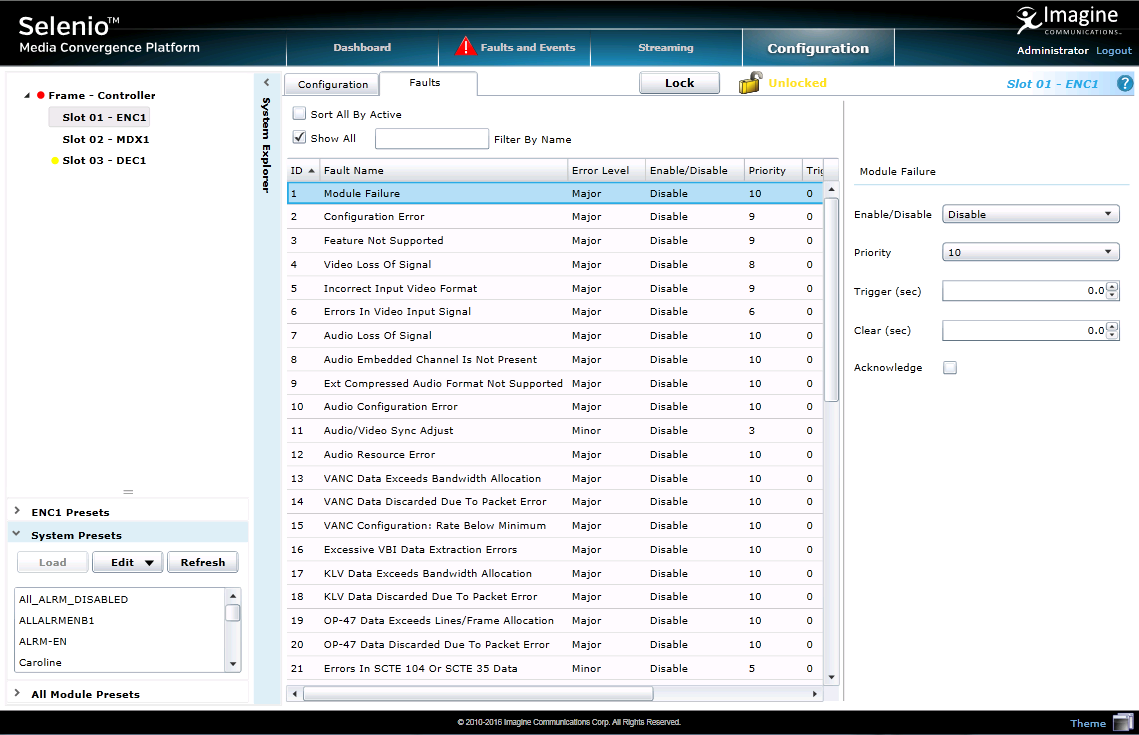
 Print
Print
Configuring Module Faults
On the dashboard for the SEL-MCP3 frame, each module that has a fault condition appears with a colored border to indicate the severity of the fault.
You can configure the faults for a module (including the Controller module) by selecting that module in the device tree, and then clicking the Faults tab on the control panel for that module.

Module Faults
Whether it is selected or not, the Faults tab indicates if the module has a fault by displaying either a yellow (minor) or red (major) fault indicator.
At the top of the panel, you can sort the faults list using the following check boxes:
- Sort all by active—Puts active faults at the top of the list. Active major faults are highlighted in red. Active minor faults are highlighted in yellow.
- Show All—Displays all active and inactive faults for the module in a continuous list.
When you select this option, you can filter by name by entering a keyword in the Sort by Name field (which appears when Show All is selected).
- Click the page numbers to the right of the Show All check box to view other pages of faults.
You can also sort the faults by the column headers, as described below.
Fault Column Headers
Column Header |
Description |
|---|---|
ID [RO] |
A sequential label for the fault—each fault has an unique ID, starting from 1 |
Fault Name [RO] |
A short description of the fault that you can use to find a longer description in the module’s manual, or in its HTML parameter list |
Error Level [RO] |
An indicator of the priority of the alarm:
|
Enable/Disable |
The master setting that determines whether the alarm will activate
|
Priority |
A number from 1-10 indicating whether a triggered fault is reported as major or minor; a priority of 6 or higher is a major fault, and a priority of 5 or lower is a minor fault |
Trigger (sec) |
The duration over which the fault condition must exist (in seconds) before the fault is triggered. If the fault level is reached for less time than the Trigger duration, then the fault will not trigger. Choose any duration from 0 to 7200 seconds (two hours). If Trigger is set to 0 and the fault condition exists for any period of time, the fault is triggered. |
Clear (sec) |
The amount of time the fault condition must be in abatement in order for the fault to be turned off. Choose any duration from 0 to 7200 seconds (two hours). If Clear is set to 0 and the fault condition ceases for any period of time, the fault is cleared. |
Ack |
An indicator as to whether or not the alarm has been acknowledged; when a fault is active, click this option to allow other users on the network to see that you have acknowledged the fault |
Active [RO] |
An indicator of whether the alarm is active (triggered) or inactive |
|
© 2018 Imagine Communications Corp. Proprietary and Confidential |
Return to Top |